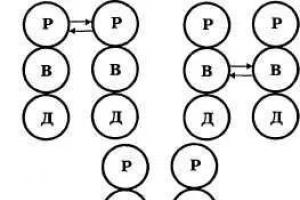Now I will install the extension on this door. The accessory will be telescopic. For those who don't know, here it is in cross-section.
This is the groove. There is a groove in the additional strip. And on the cash there is this thorn. Cashing has this profile.

Why was this done? When we place an additional amount, the cash is inserted into it. And we can adjust the distance within this pass. About one and a half centimeters.

Now, if for example, this distance is not 8 centimeters, like here. And there from 5 to 15 millimeters, we can cash out immediately without additional charges. This box is certainly not telescopic. This door has been installed for a long time. This simple box. In general, telescopic boxes contain passes here. Immediately so that the cash can be mounted there.

Where do I start installing the addition. First I saw off to height. First I trim the bottom, then here I make a mark with a stationery knife and saw it off 1 millimeter shorter.

Then, I take a square and measure this distance from the box to the edge. And add more depth to the groove. In this case it is 1 centimeter. And I make markings on the reverse side. Here's the line.

Well, here we need to take into account that you need to saw off from the side where it will be inserted into the box. Because this region cannot be spoiled. Well, here I expect the additional strip to be about a couple of millimeters less than the plane of the wall itself. Because it doesn't matter here. I can adjust these 2-3, even 5 millimeters with this cashing spike. If there are ordinary additional strips, then on the contrary, I make the width of the additional strip 1 millimeter larger. For what? So that there is enough cash in any case. And you need to measure. The walls are not always level, so I measure at several points. Well, at about 4. Up, somewhere here and down.

If the wall is approximately flat, you can do it at 3 points. And thus I adjust the left and right additional strips. Then I mount the top one on top of them, directly on them. I saw off the whole thing with a jigsaw. You can use a circular saw to cut some parquet or a mini-circular saw. I mark the top bar like this.

Here I place it like this, so that this edge of it is before the beginning of the groove. Here I also mark, right in the groove. Just a knife and that's it. Then I turn it over and put it in like this. And here we make marks as if in width. Because there are different left and right edges. This is how we make marks. Here and here. Like this.

And then I draw and cut.
Installation of the extension
So, now that all our inlaid planks are prepared, sawed off, we install them in place.
This is where the plane coincides. I check it with my fingers.

So, here is a right angle and up to the groove. This is what we get.

Like this. Why do we need to do this here? So that when we insert cash, nothing sticks out here or gets in the way. And this corner will tighten up, and that’s how it will be. Here he is.

It should be. This plane also coincides. Here she is. Here too. Everything matches.

In the case when, for example, a gap forms in this corner. Well, there is no foam there, for example, to rest against. This is where I drill and screw in screws. They seem to be a stop, and they prop up this entire corner. That's all. Now we will mount them. To do this, first I will wet this thing so that the foam will move away better. It expands more evenly.

Because foam expands when exposed to moisture. So, let's take the foam. And with these cakes I go through the entire perimeter.

Now I take the wide masking tape from me. And I fix the gain. I make sure that there is a right angle.

And so on around the entire perimeter. This is how I recorded it all. After about one hour, you can already withdraw everything and put it in cash. I will also do the same procedure on this side. From the edge and from above. That's it, the supplies will be ready. This fastening is quite enough. There is no load here. No mechanical fastening is required here. All this stuff is ready. You can say it will freeze now and that’s it. Propenil, fixed it.

Why do I do it with dots like this and not all over? Two reasons. Firstly, saving foam. Secondly, it is a guarantee that the extensions will not be squeezed out by an arc. Because the foam has room to expand into free space. That's all. The selection is done. This is done briefly within 10-15 minutes. Now I'll do some additional work on the other door. During this time, the foam will cool down and you can start cashing out.
Cashing installation
Our selection has frozen. I trimmed the foam and removed the tape. Now I will bet cash. But I will place it here at an angle of 45 degrees.

In general, telescopic cashers are installed, as a rule, cut like this at a right angle here. And from above the cash goes here, like this.

But, since this door has cashing already installed like this. This means that you need to do the same on this side too. How to mark. So I take it and put a half-mark here with a knife. Like this. That's it, I'll cut it here and here.

I put the top one first. Then I also place the vertical ones overlapping like this. This is how I put it and make a mark. This is how she stands, for example. And I did it again.

So once again I put a mark. Here she is, you can barely see her. And I cut everything off. First, of course, you need to trim the bottom, and then I applied liquid nails here on this edge. Right here. Here on this road edge, like this.

Here, here and along the entire length. And I'll slam her. Because if you glue the entire groove. This glue will fill everything, and it will be almost impossible to remove it. It’s already tight there and you just need to fix it a little. You can apply glue here. Directly on the wall, several points. It would be enough.

We put everything in. Maybe a little between them.

We install everything.

So, this is what we got in the end. This is the corner.

Here you can tint it with a pencil so that the seam is not visible. It won't rush into the gas too much. And here it is, that's all. Everything is clear and beautiful. I’ll show you now how to do the markings. Here I put it, the knife like this.

All. There is a mark. Now we take the mark like this, here. And we hold the knife at a right angle and move it. That's it, now you need to cut it diagonally. That's it, it goes to trimming. The truth here is that because there is a groove, it becomes crooked. I'm just placing a piece of wood here to the thickness of this distance.

I put it here and it sits evenly. And I saw off.
Well, this is what we got in the end. Such a bonus. Black, hard to see, well, nothing. Now I'll show you up close.

Everything is tight, everything is smooth, no cracks. This is the node. That's it, the door is absolutely ready.
All rights to the video belong to: Roman Zaitsev
Why are extras needed and what are they? Before answering this question, we need to remember a little, and young people need to study history. As it was before? Each production plant building materials strictly complied with the current state standards for its products. The sizes of bricks, blocks, panel slabs, etc. were regulated. d. Construction organizations had standards for the thickness of plaster. This allowed woodworking enterprises to produce woodwork (windows and doors) with standard door frame sizes. After installing them in the openings, no additional adjustment with additional trims for the platbands was required.
Today everything is different. The vast majority of enterprises are guided not by state standards, but by their own technical specifications. This has led to the fact that the same brick or block from different manufacturers can have different sizes. Now no one can confidently determine the thickness of the walls, make several standard sizes door and window frames are not possible. The solution was found simple and effective. The box is made with the minimum permissible width, which guarantees its physical strength, and the missing width, depending on the thickness of the walls, is gained by installing extensions.


Due to the fact that most modern door frames are made of MDF in order to reduce costs, the same material is also used during the manufacture of extensions. There are, however, door frames and trims made of natural wood, but they are rare and cost much more. The principles for installing wooden and MDF panels are no different.
Extensions are ordinary boards made of MDF, have a width from 100 mm to 200 mm, are produced by door manufacturers, and have the same color and texture as the doors. By structural device can be ordinary (simple) and adjustable. Simple extensions rest against an L-shaped cutout in the sides of the box; adjustable ones with the box have a tongue/groove connection. This allows you to accurately adjust the protrusion after taking the preliminary dimensions and preparing the extensions. In addition, the presence of the connection somewhat simplifies and speeds up the foaming process.

| Photo | Size | Color | Price |
|---|---|---|---|
| 8x100x2070 mm | bleached oak | 114.00 RUB/pcs. | |
| 10x100x2070 mm | Italian walnut | 167.00 RUB/pcs. | |
| 12x2150x2150 mm | snow rosewood | 188.00 RUB/pcs. | |
| 12x80x2100 mm | pine | 193.00 RUB/pcs. | |
| - | acacia | RUB 2,192.00/piece | |
| 100x2150 mm | nut | RUB 468.00/piece |

We will look at installation methods for both types of extensions, starting with simple ones.
Installation of simple extensions

Simple additions can be connected with foam (the most quick way), nails and screws (the longest method). Choose the method that seems most appropriate to you, experienced builders install extensions only on foam. The method of installing the extensions has almost no effect on the reliability of fastening the platbands, and the work is significantly simplified and accelerated.
Adjustable extensions are installed only on foam.

Measuring and preparing accessories
The technological task of the extensions is to serve as a platform for attaching platbands. In order for the platbands to lie correctly, the end of the extensions must lie in line with the plane of the wall. Measurements should be taken on an already installed door frame. Sizing is performed in the following ways.

Now you need to find out the height of the left and right elements and the length of the horizontal one. At the top of the box, the extensions are connected by the letter P, take this into account when taking dimensions.
You can cut additional boards with a hand saw, a jigsaw, or a portable electric saw or at stationary machine. The latter option is preferable - the work is much faster, its accuracy increases and the risks of chipping are minimized.



First, cut the pieces to length, then make width marks on each one at the ends. Draw a straight, even line and carefully cut off the excess part. It is better to draw a straight line using the same extensions; you don’t have to look for straight and long wooden slats. At the cut site, you need to remove a small chamfer, so the board will fit more tightly to the door frame.
Video - Measuring extras
All elements are prepared, you can start installing them. Let's start with the most complex method and end with the simplest.
Installing extensions with self-tapping screws
Step 1. On the extensions, make a hole for the screws.

The thickness of the MDF boards is 10 millimeters; for melting you need to take a drill with a diameter of no more than 9 millimeters. The exact diameter should be coordinated with the diameter of the screw head. The diameter of the caps, in turn, changes with their length. The length of the screws is selected so that they fit into door frame two or three turns, otherwise it may crack.

It is advisable that the drills be made to look like wood; they have thin needle-like protrusions at the end, which allow more accurate centering of the hole and prevent the drill from moving during drilling.
Important. Always leave at least 1.5 mm of board thickness on the side of the front part of the extension; there is nothing to worry about if the hole for the countersunk completely drills out the side of the extension with reverse side. The depth of the hole is regulated by the length of the screws; the main condition, as we have already mentioned, is that they should be screwed into the box no more than two or three turns. In total, it is enough to install 4 screws for the long vertical part, and make the same number of holes.
Step 2. Drill holes for screws. The diameter of the drill must correspond to the diameter of the screws. Drilling these holes is somewhat more difficult; you need a keen eye and dexterity.

How to drill them?
- It is better to drill holes on the back side of the holes for the countersunk.
Very important. You will need to drill not perpendicular to the plane of the board, but at a slight angle. This is done so that the self-tapping screw is directed towards the center of the door frame - the possible risks of cracking on the front part are reduced. If the end of the screw comes out from the back of the box, there is nothing to worry about.
- Place the drill perpendicular to the drilling plane exactly opposite the hole for the countersunk.
- Drill a few millimeters deep, turn off the drill. Place the drill under the right angle and continue drilling until its end appears in the hole for the countersunk.


We have already mentioned that this method is the most difficult, and we do not recommend using it. But, if someone has convinced you, then we will continue to talk about him. Prepare all the elements of the accessories using the described method.
Step 3. Insert the screws into the holes and twist them until the ends appear on the opposite side.

Step 4. Screw on the vertical extensions first, then the horizontal ones. If the self-tapping screw is tightly screwed, do not use much force, unscrew it a few turns, and then screw it in again.



Step 5. Check the position of the extensions; if there are places with a loose fit to the door frame, press them with any available materials.
Step 6. Prevent the boards from bending with polyurethane foam.

To do this, you can fix them in two ways: with construction paper tape or spacers. Construction tape has high tensile strength in the perpendicular direction and calmly holds the force of the foam. If the wall is smooth, use carpenter's tape and stick it to the paneling and the wall in three or four places on the vertical elements and two or three on the horizontal ones.
If the tape does not stick to the wall, use spacers. They can be made from wooden slats. The length of the slats should be 1÷2 centimeters shorter than the width of the doors. Subsequently, the spacers are pressed with various pads.
Step 7 Fill the gap between the wall and the extensions with polyurethane foam.

Very important. It is rare to find responsible builders who, before foaming any structures, clean them of dust and wet the surfaces. And foam has very weak adhesion to dry surfaces; there is nothing to say about dust and dirt. Try to touch fresh foam with a wet finger - then you won’t be able to wash it off with anything.
For foaming, use any foam, the extensions are not a door frame, they do not carry any load, you can use the cheapest brands. The main thing is don’t leave any gaps. If the gap between the wall and the extension is narrow and deep, adapt it to the nozzle various extension cords. For very thin cracks, we used cocktail tubes - we taped them to the existing outlet of the foam can and worked. This design, however, is disposable, but you don’t need more.

Step 8 Wait at least 24 hours for the foam to cool, and use a sharp mounting knife to cut off any excess. Check the stability of the position of the extensions by tapping. If you find problem areas, add foam to them.

Video - Installing extensions with screws
That's it, the work on installing the extensions is finished, you can start working with
Installation of extensions on studs
In this section we will talk about another way to measure the dimensions of the extensions. They need to be inserted one by one into the seats of the door frame and using the sharp side of the rule to draw a wall line.

You must act carefully. If you inserted additional elements in the position in which they will be fixed, then the marked line must be symmetrically moved to the other side of the board and only cut along it. But you can insert the board rotated, then the line will immediately be in its place. Further, all circumcision operations are identical to those described above.
Step 1. Using a small diameter drill (should correspond to the diameter of the finishing nails no more than one millimeter), drill holes at a distance of approximately 20 cm in the end of the extension adjacent to the door frame.

In the photo - the finishing nail next to the finisher
Important. Drill carefully and keep the drill strictly vertical. The depth of the holes should be 3–5 millimeters less than the length of the nails.
Step 2. Insert the nails into the drilled holes until they stop. Before this, you need to bite off the caps with pliers; the carnations are inserted with the sharp end outward.
Step 3. Carefully insert each accessory element one by one into its place in the door frame. Using a hammer, drive the sharp protruding ends of the nails into the door frame through the wood spacer. Take your time; before fixing, firmly press the additional element against the side of the protruding seat of the box. If you are inattentive and miss a gap, you will have to remove the additional element and start all over again or seal the gap with sealant that matches the door. Both options are highly undesirable. In the first case, because you will have to pull out the “wrong” nail and drill a hole for it in another place. The fact is that the incorrect fastening is located a few tenths of a millimeter from the correct one. And in this case, the nail will never make a new hole for itself, but will always slide into the existing one. In the second case, any sealing of cracks with sealant will not go unnoticed and will indicate the low professionalism of the performer.

Step 4. Wedge the extensions on the back side, secure their position with tape or spacers to prevent them from bursting with foam.
Step 5. Clean the surfaces from dust and dirt, moisten them with an ordinary water spray (spray).

Step 6. Fill the gap with sealant over the entire surface. After the foam has cooled, carefully cut off the protruding part.

Video - Installing extensions on studs
We deliberately left the simplest method for last, this will give you the opportunity to compare all the described methods and make right choice. Marking and cutting out elements is no different from the first two.

And then everything is simple. Put the extensions in place, wedge them with inside until the surfaces are completely pressed against seats prevent the door frame from bursting with tape or spacers and foam it after cleaning and wetting the surfaces. As you can see, there are no steps, drilling or hammering. Why do we recommend using this particular method?
- The strength of such an installation is no different from complex methods.
- You never run the risk of damaging the extensions while drilling holes or driving in nails for one simple reason - there are no holes or nails.
- While the “big” specialist is drilling holes for screws or nails, you will completely install the extensions on two door frames yourself with the same quality of work as him.

Have you compared how many fewer technological operations there are, how much less there is the risk of damage to the doors and door frames, and how many more advantages there are? Now make your decision.
Video - Installing foam extensions
Installation of adjustable extensions
Adjustable extensions have several advantages.
- Connecting the elements into a tongue/groove allows the elements to be tightly pressed with visible planes. The appearance of cracks is completely eliminated; there is no need to wedge them.

- The extensions can move up/down or out/in in the door frame. These few “free” millimeters allow you to precisely adjust their location and compensate possible mistakes during measuring or sawing.


Such extensions also have a drawback - they cannot be installed without a stationary circular. The fact is that only a stationary circular saw can be used to cut a tenon of the required thickness and depth on additional elements.
How are they installed?
Step 1. Take measurements, while taking into account the depth of the groove on the door frame. You can measure it and add it to the resulting width values, or you can take a piece thin plywood or a ruler, insert it into the groove and in this position measure the width of the extensions. Take measurements in several places around the entire perimeter of the doorway; walls are often uneven.
Step 2. Mark the left and right extensions and transfer the dimensions to the blanks.
Important. In order to simplify the installation of all elements in the future, reduce their width by 2–3 millimeters. This reserve will make it possible to move the extensions in the grooves in the desired direction.
Step 3. Cut the blanks to length and width.
Step 4. Set the stop circular saw by the width of the tenon, raise the saw table in such a way as to ensure the required height of the tenon. Place the board on the edge and carefully cut out the tenon.

Step 5. In the same way, prepare all the remaining elements of the additions.
Everything else is simple. Install them in place, align them at the joints and along the plane of the wall. To prevent expansion, stick construction tape to the wall and extensions, clean the surfaces from dirt and dust, wet them and foam them. The presence of a tongue/groove connection eliminates the need for wedging; the extensions already hold their size perfectly and are tightly pressed to the door frame.
Video - Installation of adjustable extensions
When installing accessories, do not create unnecessary problems and difficulties for yourself, use only the third most in a simple way– installation on foam. Why?
- Firstly, the extensions are never affected by pulling forces; in any case, they will reliably hold the platbands.
- Secondly, the nails serve only to securely press the extensions to the door frame, and do not keep them from being pulled out. Ordinary wedges made of polystyrene foam, paper and other available materials cope with the same task no worse.
- Thirdly, any “drilling” in thin boards and in the door frame can cause cracks to appear on the front side. You will have to change the accessory or repair the box.
No one needs the first, second, and third. Why are there the first two installation methods? We think this is one of the effective methods undeserved increase in wages for unscrupulous builders. They importantly tell customers what kind of complex work you need to pay the appropriate amounts.

You should not nail the horizontal expansion to the vertical ones in the corners of the joints; it is already perfectly pressed with foam. If you are worried, press it in these places with any wedges. Extra nails in thin trims are an extra chance to see a hole on the front part, and this is a direct defect in the work.

Do not nail the planks together
You may find advice to connect all the elements with the letter P before installing the extensions in the door frame. We do not recommend doing this for two reasons.
- Firstly, it does not reduce, but increases installation time.
- Secondly, the connection is “flimsy”; during the movement and installation of the structure, the nails will still move a little and a gap will appear between the horizontal and vertical extensions. In any case, it will need to be eliminated on the spot.
- Thirdly, the structure may become so distorted during transportation that the nails will break the integrity front side doborov. This is a very unpleasant situation; it will never be possible to repair the crack “to its original state.” Experienced master will always see the problem area.
And one last piece of advice. Sometimes there are times when you have to invite a specialist to help. You install several yourself door trims, and a few must be installed by the wizard. Perhaps you want to finish this stage of building a bathhouse as quickly as possible, or you don’t have enough time, your vacation is ending, but you want to finish finishing the bathhouse as soon as possible, the reasons may be different.

The master has come - look what tools he has. If they are dirty, it is immediately obvious that they are not being looked after - refuse the services of such a master. If among his tools you see sealants for cracks, shake the “craftsman’s” hand and send him back. Modern doors made of MDF must be installed so accurately that the presence of cracks only indicates carelessness, inexperience or irresponsibility of the master.
Video - Installing a door extension
November 20, 2016
Specialization: master in construction plasterboard structures, finishing works and styling floor coverings. Installation of door and window units, finishing of facades, installation of electrical, plumbing and heating - I can give detailed advice on all types of work.
Today I will tell you how I installed MDF trims and platbands. All photographs were taken during the work in my apartment, I also shot a video of the process so that you can understand it as best as possible. In my opinion, the work is not difficult, and the main thing that is required is accuracy and precision so as not to spoil the materials.
The working process
I divided all the work into 3 parts:
- Preparation of materials and openings;
- Cutting and fastening of extensions;
- Cutting and fastening the platband.
Let's consider all the stages in order.
Stage 1 – preparation

To work we need the following:
- Platband in required quantity, the calculation is usually carried out in the store;

- Extras the right size. Here it should be noted that the elements are sold in the form, which must be cut in half when used. It is important to correctly measure the width to be closed in order to purchase what you need.

From the tool I used the following:
- A tape measure and a square for marking, and a tape measure for measuring all the required parameters;
- A jigsaw for cutting works best using special blades with small tooth sizes, they provide ideal quality of work and do not leave burrs on the ends;

- Knife for cutting off excess foam around door frames.
As part of the preparation, one more important job needs to be done: cut the foam so that it is flush with the surface of the wall. The work is simple, you need a knife with a sharp blade, with its help the excess is cut and removed, it is important to do the work carefully and not cut the foam deep, keep the blade parallel to the wall.

Stage 2 – installation of extensions

Additional elements are placed on the side of the box where it is recessed into the opening. That is, on one side our structure is flush with the wall, and on the other we need to install additional spacers.
The workflow consists of the following steps:

- The length of the products is measured; for this, the edge of the tape measure is inserted into the groove, and the tape is lowered to the level along which the bottom of the element will pass;
- The extension dissolves into two parts; you need to cut it in the middle of the groove so that you end up with two units that we will use. You can mark the cutting line, or you can do without it;



- After the panels are unraveled, we need to cut the element to the length we require. The main thing is to mark the plank correctly and cut it smoothly (when marking, use a square);
- The product prepared in this way is aligned along the top edge and carefully hammered into the groove to the level we need. You don't need hammers or other tools, everything works out much faster with the back of your hand. The element on the second side is also installed;

- After installing the side elements, the size of the upper part is measured and a piece of the required size is cut. When installing, make sure that the extension is level and the system is not distorted;


Stage 3 - installation of platband
The platband, unlike the extension, is installed on both sides of the opening, so the work takes more time and consists of the following actions:
- First of all, the length of the side elements is measured. Everything here is the same as with extensions - you need the length from the groove to the base;
Always check the ends of the platband, all of our strips were cut crookedly, and I had to cut the elements not on one, but on both sides to get the ideal geometry of the products.

- The side elements are put in place, there is no particular difference from which side the work is carried out, the main thing is to align the platband exactly along the top part, after which it is also hammered in with the palm of your hand until it stops, a very strong connection is obtained without the use of glue and nails;


- When the side elements are installed, the width can be measured top bar. It is very important to determine the size accurately, it depends on appearance blocks, any inaccuracies will be very clearly visible;

- A piece is cut off required length, let me remind you once again about the importance of perpendicular corners and straight ends, mark everything with a square and cut carefully;
- The element is tried on at its future location, since it is wider than the groove of the box, it is necessary to cut off the excess protrusions so that they do not rest against the wall. It is important to accurately mark the cutting line;

- The protrusion is cut flush with the plane of the reverse side of the casing; the photo shows the final result of the work;

- The trim is positioned and carefully hammered into place - you can enjoy the excellent result of the work.

Conclusion
I recommend watching the video; many points are shown clearly and explained in more detail; it also discusses the option of framing a narrow space near the box when the trim does not fit. I hope that you will understand the process, and if you still have questions, write them in the comments.








